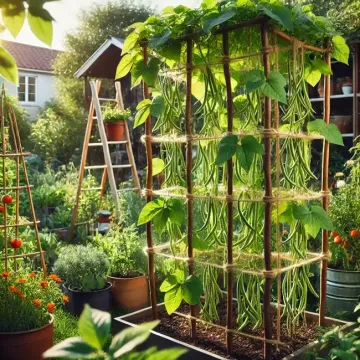Introduction to Pole Beans
Pole beans are a variety of green beans that grow as climbing vines, rather than the bushy plants of bush beans. They come in various types, including snap beans, string beans, and shell beans. Pole beans are favored for their long production period, often yielding beans continuously until frost if picked regularly.
Some popular varieties of pole beans include:
- Kentucky Wonder: A classic variety known for its delicious, tender pods.
- Blue Lake: Another favorite, praised for its consistent production and excellent flavor.
- Scarlet Runner: Known for its vibrant red flowers and large, tasty beans.
Benefits of Growing Pole Beans
- Space Efficiency: Pole beans grow vertically, requiring minimal horizontal space. This makes them a great choice for gardens with limited space.
- Higher Yields: Due to their climbing nature, pole beans typically produce more beans per plant than bush varieties.
- Longer Harvest Period: Unlike bush beans, which tend to produce a single, concentrated harvest, pole beans continue producing beans over a longer period.
- Aesthetic Appeal: Many pole bean varieties, like the Scarlet Runner, have attractive flowers that add beauty to the garden.
Growing Conditions
- Soil: Pole beans prefer well-drained, fertile soil with a pH between 6.0 and 7.0. Adding compost or well-rotted manure can enhance soil fertility.
- Sunlight: They thrive in full sun, needing at least 6-8 hours of sunlight per day.
- Water: Consistent watering is crucial, especially during flowering and pod development. Water the base of the plants to avoid wetting the foliage, which can lead to fungal diseases.
Trellising Methods for Pole Beans
Providing sturdy support is essential for pole beans, as their vines can grow 6 to 10 feet tall. Here are some popular trellising methods:
- Teepee or Tripod Trellis:
- Constructed from bamboo poles, wooden stakes, or even sturdy branches, this trellis resembles a teepee or tripod.
- The poles are arranged in a circular formation, with the tops tied together. This method offers excellent stability and provides ample space for beans to climb.
- Plants are typically spaced at the base of each pole, and as they grow, they naturally twine around the poles.
- String Trellis:
- This method uses vertical strings or twine attached to a horizontal support, such as a wooden or metal frame.
- Place the frame at the top of the growing area, and let the strings hang down to the base of the plants. Guide the beans to climb the strings as they grow.
- String trellises are space-efficient and easy to construct. However, they may require frequent adjustments to ensure the vines are climbing properly.
- A-Frame Trellis:
- This method involves creating an A-frame structure using wooden stakes, lattice, or wire mesh.
- The A-frame provides a large surface area for the beans to climb, and it can be easily adjusted for different garden layouts.
- A-frames are sturdy and allow for easy access to the beans when harvesting.
- Fence or Wall Trellis:
- If you have a garden fence or wall, it can double as a trellis for pole beans. Attach mesh, netting, or a grid of strings to the fence, and the beans will climb naturally.
- This method works well for saving space and can also add a touch of greenery to otherwise bare walls or fences.
- Arched Trellis:
- An arched trellis can add an architectural element to your garden. It allows beans to climb overhead, creating a tunnel of greenery and beans.
- This method is both functional and decorative, perfect for gardeners who want to create a focal point in their garden.
Planting and Care Tips
- Direct Sowing: Pole beans should be sown directly in the garden once the soil has warmed to at least 60°F (16°C) and all danger of frost has passed.
- Spacing: Space seeds about 4-6 inches apart, and if planting multiple rows, leave about 3 feet between rows to accommodate the trellis.
- Mulching: Apply mulch around the base of the plants to help retain moisture and suppress weeds.
- Fertilization: Beans typically fix nitrogen in the soil, so they do not require much fertilization. However, adding compost or a balanced fertilizer can help promote healthy growth.
- Pest Management: Keep an eye out for common pests like aphids, bean beetles, and spider mites. Handpicking pests or using organic sprays can help manage infestations.
Harvesting Pole Beans
Pole beans are ready to harvest when the pods are firm, crisp, and about 4-6 inches long, depending on the variety. Regular harvesting encourages the plant to produce more beans. Pick beans while they are young and tender for the best flavor and texture.
Growing pole beans in your home garden is a rewarding experience that offers both aesthetic and culinary benefits. With the right trellising methods and care, your pole beans can thrive, providing a bountiful harvest throughout the growing season. Whether you're new to gardening or an experienced grower, pole beans are a versatile and productive crop to include in your garden.

